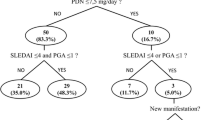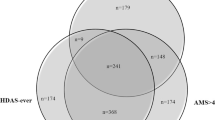Abstract
Objective
To determine the impact of homocysteine levels on damage accrual in systemic lupus erythematosus (SLE) patients.
Methods
This longitudinal study was conducted in consecutive patients seen every 6 months at our Rheumatology Department since 2012. Patients with available homocysteine levels and who had at least one subsequent visit were included. Univariable and multivariable Cox regression models were done to determine if homocysteine levels were predictive of damage accrual as per the SLICC Damage Index (SDI). The multivariable model was adjusted for pertinent variables (age at diagnosis, gender, socioeconomic status, disease duration, disease activity (SLEDAI), Framingham score, antimalarial and immunosuppressive drug use, average daily dose, and exposure time to prednisone (PDN)).
Results
One hundred forty-five patients were included; their mean (SD) age at diagnosis was 43.70 (12.09) years, 136 (93.8%) were female, and nearly all were Mestizo. At baseline, disease duration was 7.55 (6.73) years; patients were followed for 3.54 (1.27) years. The SLEDAI was 5.60 (4.34), and the SDI 0.97 (1.35). The average daily PDN dose was 7.30 (5.78) mg/day and the time of PDN exposure was 7.36 (6.73) years. Mean homocysteine levels were 10.07 (3.71) μmol/L. The highest tertile of homocysteine levels predicted new damage accrual in the univariable and multivariable models [HR 1.78 (95% CI, 1.042–3.039); p = 0.035 and HR 2.045 (95% CI, 1.077–3.883); p = 0.029, respectively]. Increased levels (> 15 μmol/L) were found in 12 (8.3%) patients; 75 (51.7%) patients increased ≥ 1 SDI point.
Conclusion
In SLE patients, homocysteine levels predicted damage accrual independently of other well-known risk factors for such occurrence.



Similar content being viewed by others
Change history
29 April 2019
The affiliations of <Emphasis Type="Bold">Manuel F. Ugarte-Gil,</Emphasis> one of the author of the above article has a discrepancy between the online version of the publisher’s internet portal (<ExternalRef><RefSource>Springerlink.com</RefSource><RefTarget Address="http://springerlink.com" TargetType="URL"/></ExternalRef>) and the online pdf version.
References
Manzi S, Meilahn EN, Rairie JE, Conte CG, Medsger TA Jr, Jansen-McWilliams L, D'Agostino RB, Kuller LH (1997) Age-specific incidence rates of myocardial infarction and angina in women with systemic lupus erythematosus: comparison with the Framingham Study. Am J Epidemiol 145:408–415
Bruce IN, Urowitz MB, Gladman DD, Ibañez D, Steiner G et al (2003) Risk factors for coronary heart disease in women with systemic lupus erythematosus: the Toronto Risk Factor Study. Arthritis Rheum 48(11):3159–3167. https://doi.org/10.1002/art.11296
Petri M, Roubenoff R, Dallal GE, Nadeau MR, Selhub J, Rosenberget IH (1996) Plasma homocysteine as a risk factor for atherothrombotic events in systemic lupus erythematosus. Lancet 348:1120–1124. https://doi.org/10.1016/S0140-6736(96)03032-2
Svenungsson E, Jensen-Urstad K, Heimburger M, Silveira A, Hamsten A, de Faire U et al (2001) Risk factor for cardiovascular disease in systemic lupus erythematosus. Circulation 104:1887–1893
Refai TMK, Al-Salem H, Nkansa-Dwamena D, Al-Salem MH (2002) Hyperhomocysteinaemia and risk of thrombosis in systemic lupus erythematosus patients. Clin Rheumatol 21:457–461. https://doi.org/10.1007/s100670200115
Asanuma Y, Oeser A, Shintani AK, Turner E, Olsen N, Fazio S (2003) Premature coronary artery atherosclerosis in systemic lupus erythematosus. N Engl J Med 349:2407–2415. https://doi.org/10.1056/NEJMoa035611
Petri M, Fu W (2016) Hyperhomocysteinemia in SLE [abstract 2792]. Arthritis Rheumatol 68(suppl 10):3744–3347
Moroni G, Novembrino C, Quaglini S, , De Giuseppe R, Gallelli B, Uva V, et al (2010) Oxidative stress and homocysteine metabolism in patients with lupus nephritis. Lupus 19(1):65–72. doi: https://doi.org/10.1177/0961203309346906
Bonciani D, Antiga E, Bonciolini V, Verdelli A, Del Bianco E, Volpi W et al (2016) Homocysteine serum levels are increased and correlate with disease severity in patients with lupus erythematosus. Clin Exp Rheumatol 34(1):76–81
Škovierová H, Vidomanová E, Mahmood S, Sopková J, Drgová A, Červeňová T, Halašová E, Lehotský J (2016) The molecular and cellular effect of homocysteine metabolism imbalance on human health. Int J Mol Sci 17(10):1733. https://doi.org/10.3390/ijms17101733
Durand P, Prost M, Loreau N, Alberts MJ, Benavente O, Furie K et al (2011) Impaired homocysteine metabolism and atherothrombotic disease. Lab Investig 81(5):645–672
Faraci FM, Lentz SR (2004) Hyperhomocysteinemia, oxidative stress, and cerebral vascular dysfunction. Stroke 35:345–347. https://doi.org/10.1161/01.STR.0000115161.10646.67
Tam LS, Fan B, Li EK, Thomas GN, Yim SF, Haines CJ et al (2003) Patients with systemic lupus erythematosus show increased platelet activation and endothelial dysfunction induced by acute hyperhomocysteinemia. J Rheumatol 30(7):1479–1484
Skaggs BJ, Hahn BH, McMahon M (2012) Accelerated atherosclerosis in patients with SLE—mechanisms and management. Nat Rev Rheumatol 8(4):214–223. https://doi.org/10.1038/nrrheum.2012.14
Lazzerini PE, Capecchi PL, Selvi E, Lorenzini S, Bisogno S, Galeazzi M, Laghi Pasini F (2007) Hyperhomocysteinemia, inflammation and autoimmunity. Autoimmun Rev 6:503–509. https://doi.org/10.1016/j.autrev.2007.03.008
Schroecksnadel K, Frick B, Wirleitner B, Winkler C, Schennach H, Fuchs D et al (2004) Moderate hyperhomocysteinemia and immune activation. Curr Pharm Biotechnol 5:107–118. https://doi.org/10.1515/CCLM.2003.221
Gualtierotti R, Biggioggero M, Penatti AE, Meroni PL (2010) Updating on the pathogenesis of systemic lupus erythematosus. Autoimmun Rev 10:3–7. https://doi.org/10.1016/j.autrev.2010.09.007
Mak A, Cheung MW, Chiew HJ, Liu Y, Ho RC (2012) Global trend of survival and damage of systemic lupus erythematosus: meta-analysis and meta-regression of observational studies from the 1950s to 2000s. Semin Arthritis Rheum 41:830–839. https://doi.org/10.1016/j.semarthrit.2011.11.002
Ugarte-Gil MF, Gamboa-Cárdenas RV, Zevallos F, Medina M, Cucho-Venegas JM, Perich-Campos RA, Alfaro-Lozano JL, Rodriguez-Bellido Z, Alarcón GS, Pastor-Asurza CA (2014) High prolactin levels are independently associated with damage accrual in systemic lupus erythematosus patients. Lupus 23:969–974. https://doi.org/10.1177/0961203314531083
Hochberg MC (1997) Updating the American College of Rheumatology revised criteria for the classification of systemic lupus erythematosus. Arthritis Rheum 40(9):1725. https://doi.org/10.1002/1529-0131(199709)40:9<1725::AID-ART29>3.0.CO;2-Y
Méndez-Csstellano HM, Méndez MC (1994) Sociedad y Estratificación. Método Graffar-Méndez Castellano FUNDACREDESA, Caracas, pp 7–35
Gladman DD, Ibañez D, Urowitz MB (2002) Systemic lupus erythematosus disease activity index 2000. J Rheumatol 29(2):288–291
Gladman D, Ginzler E, Goldsmith C, Fortin P, Liang M, Urowitz M et al (1996) The development and initial validation of the Systemic Lupus International Collaborating Clinics/American College of Rheumatology damage index for systemic lupus erythematosus. Arthritis Rheum 39:363–369. https://doi.org/10.1002/art.1780390303
Sabio JM, Vargas-Hitos JA, Martinez-Bordonado J, Navarrete-Navarrete N, Díaz-Chamorro A, Olvera-Porcel C, Zamora-Pasadas M, Jiménez-Alonso J (2014) Relationship between homocysteine levels and hypertension in systemic lupus erythematosus. Arthritis Care Res (Hoboken) 66(10):1528–1535. https://doi.org/10.1002/acr.22340
Afeltra A, Vadacca M, Conti L, Mitterhofer AP, Ferri GM, Del Porto F et al (2005) Thrombosis in systemic lupus erythematosus: congenital and acquired risk factors. Arthritis Rheum 53(3):452–459. https://doi.org/10.1002/art.21172
Guthikonda S, Haynes WG (2006) Homocysteine: role and implications in atherosclerosis. Curr Atheroscler Rep 8(2):100–106
Malinow MR, Nieto FJ, Szklo M, Chambless LE, Bond G (1993) Carotid artery intimal-medial wall thickening and plasma homocyst(e)ine in asymptomatic adults. The atherosclerosis risk in communities study. Circulation 87(4):1107–1113
Perna M, Roman M, Alpert D, Crow MK, Lockshin MD, Sammaritano L et al (2010) Relationship of asymmetric dimethylarginine and homocysteine to vascular aging in systemic lupus erythematosus patients. Arthritis Rheum 62(6):1718–1722. https://doi.org/10.1002/art.27392
Roman MJ, Crow MK, Lockshin MD, Devereux RB, Paget SA, Sammaritano L, Levine DM, Davis A, Salmon JE (2007) Rate and determinants of progression of atherosclerosis in systemic lupus erythematosus. Arthritis Rheum 56:3412–3419. https://doi.org/10.1002/art.22924
McMahon M, Skaggs BJ, Grossman JM, Sahakian L, FitzGerald J, Wong WK, Lourenco EV, Ragavendra N, Charles-Schoeman C, Gorn A, Karpouzas GA, Taylor MB, Watson KE, Weisman MH, Wallace DJ, Hahn BH (2014) A panel of biomarkers is associated with increased risk of the presence and progression of atherosclerosis in women with systemic lupus erythematosus. Arthritis Rheumatol 66(1):130–139. https://doi.org/10.1002/art.38204
Castejon R, Jimenez-Ortiz C, Rosado S, Tutor-Ureta P, Mellor-Pita S, Yebra-Bango M et al (2016) Metabolic syndrome is associated with decreased circulating endothelial progenitor cells and increased arterial stiffness in systemic lupus erythematosus. Lupus 25(2):129–136. https://doi.org/10.1177/0961203315603138
Desai A, Lankford HA, Warren JS (2001) Homocysteine augments cytokine-induced chemokine expression in human vascular smooth muscle cells: implications for atherogenesis. Inflammation 25:179–186
Wang G, O K (2001) Homocysteine stimulates the expression of monocyte chemoattractant protein-1 receptor (CCR2) in human monocytes: possible involvement of oxygen free radical. Biochem J 357:233–240. https://doi.org/10.1042/bj3570233
Tso TK, Huang WN, Hy H, Chang CK (2006) Relationship of plasma interleukin-18 concentrations to traditional and nontraditional cardiovascular factors in patients with systemic lupus erythematosus. Rheumatology 45:1148–1153. https://doi.org/10.1093/rheumatology/kel082
Deng J, Lu S, Liu H, Liu B, Jiang C, Xu Q et al (2017) Homocysteine activates B cells via regulating PKM2-dependent metabolic reprogramming. J Immunol 98(1):170–183. https://doi.org/10.4049/jimmunol.1600613
Padjas A, Undas A, Swadźba J, Musial J (2007) Antibodies to N-homocysteinylated albumin in patients with systemic lupus erythematosus. Pol Arch Med Wewn 117(3):80–85
Sabio J, Vargas J, Martínez J, Navarrete N, Díaz A, Olvera C et al (2016) Cumulated organ damage is associated with arterial stiffness in women with systemic lupus erythematosus irrespective of renal function. Clin Exp Rheumatol 34(1):53–57
Urowitz M, Ibañez D, Su J, Gladman D (2016) Modified Framingham risk factor score for systemic lupus erythematosus. J Rheumatol May 43(5):875–879. https://doi.org/10.3899/jrheum.150983
Bruce IN, O'Keeffe AG, Farewell V, Hanly JG, Manzi S, Su L, Gladman DD, Bae SC, Sanchez-Guerrero J, Romero-Diaz J, Gordon C, Wallace DJ, Clarke AE, Bernatsky S, Ginzler EM, Isenberg DA, Rahman A, Merrill JT, Alarcón GS, Fessler BJ, Fortin PR, Petri M, Steinsson K, Dooley MA, Khamashta MA, Ramsey-Goldman R, Zoma AA, Sturfelt GK, Nived O, Aranow C, Mackay M, Ramos-Casals M, van Vollenhoven RF, Kalunian KC, Ruiz-Irastorza G, Lim S, Kamen DL, Peschken CA, Inanc M, Urowitz MB (2015) Factors associated with damage accrual in patients with systemic lupus erythematosus: results from the Systemic Lupus International Collaborating Clinics (SLICC) Inception Cohort. Ann Rheum Dis 74(9):1706–1713. https://doi.org/10.1136/annrheumdis-2013-205171
Fu W, Petri M (2016) Treatment of homocysteine improves urine protein/Cr ratio in SLE [abstract 963]. Arthritis Rheumatol 68(suppl 10):1276–1277
Funding
The Almenara Lupus Cohort is partially supported by three institutional grants from EsSalud (1483-GCGP-ESSALUD-2013, 1733-GCGP-ESSALUD-2014 and the 2015 Kaelin Prize 2015) and one from the Panamerican League of Associations for Rheumatology (PANLAR) (2015 PANLAR Prize).
Author information
Authors and Affiliations
Contributions
All authors were involved in drafting or critically revising this manuscript for important intellectual content, and all authors approved the final version to be published. Drs. Paola A. Zeña Huancas and Manuel F. Ugarte-Gil have full access to all the study’s data and take responsibility for their integrity and the accuracy of the analyses performed.
Corresponding author
Ethics declarations
Disclosures
None.
Additional information
Publisher’s Note
Springer Nature remains neutral with regard to jurisdictional claims in published maps and institutional affiliations.
Electronic supplementary material
Supplementary Table 1
(DOCX 15 kb)
Rights and permissions
About this article
Cite this article
Zeña-Huancas, P.A., Iparraguirre-López, H., Gamboa-Cárdenas, R.V. et al. Homocysteine levels are independently associated with damage accrual in systemic lupus erythematosus patients from a Latin-American cohort. Clin Rheumatol 38, 1139–1146 (2019). https://doi.org/10.1007/s10067-018-4389-3
Received:
Revised:
Accepted:
Published:
Issue Date:
DOI: https://doi.org/10.1007/s10067-018-4389-3




